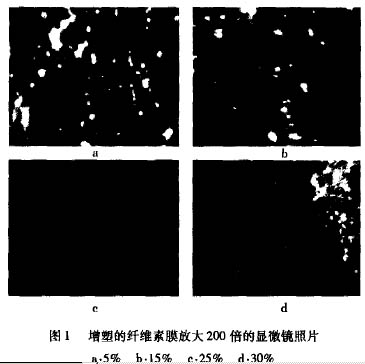Abstract: The natural fibrin film is directly dried without any treatment, and the film is brittle and curled. The glycerin was used as a plasticizer to change the flexibility of the fibrin film, and the effects of different plasticization conditions on the surface structure and properties of the cellulose film and the plasticization mechanism of glycerin were studied. Through mechanical properties testing, surface morphology observation and infrared spectrum analysis, studies have shown that glycerol changes the flexibility of cellulose film to a certain extent, but at the same time it deteriorates the mechanical properties of cellulose film, and the plasticized film After washing, glycerol is easy to lose and the plasticizing effect is reduced.
Keywords: plasticizer cellulose film infrared spectrum plasticization mechanism
Cellulose is a kind of biodegradable polymer. It has excellent performance in use and can be rapidly decomposed into low molecules under the action of microorganisms after being discarded. Cellulose is a naturally occurring and renewable natural resource. According to statistics of experts, the annual exploitation of plant synthesis in the world can produce hundreds of millions of tons of cellulose, which is not comparable to petroleum. If we can effectively and fully utilize this precious resource, it will bring great benefits to mankind.
In the destruction of the ecological environment, environmental protection has become a common concern of the international community. The use and development of cellulose has become a research topic for scientists at home and abroad. The production of various membranes using plant cellulose has been included in the development target. Compared with synthetic polymer films, cellulose films have higher dimensional stability, good processability, and are non-toxic, harmless, and biodegradable. However, cellulose membranes that have not been plasticized are brittle, curled, and easily torn, which can be said to have little effect. It has been reported that copper ammonia regenerated cellulose film and casein blend can improve the film's toughness. Kaimins added triethylphenylammonium hydroxide as a plasticizer to cellulose, which can significantly reduce the phase transition temperature of cellulose. The plasticizing effect of glycerol monoether compounds and diethanolamine derivatives on cellulose films has also been reported. They believe that the addition of such plasticizers promotes the relaxation of amorphous regions of cellulose, but these research results have not been used in industrial production.
The usual method for plasticizing cellulose films is through an aqueous solution of glycerin, which acts as a plasticizer during this process. Glycerol concentration, plasticization time, plasticizing bath temperature all have a certain effect on the cellulose membrane, but the temperature changes have little effect on the membrane performance. In order to investigate the effect of glycerin plasticization treatment on the surface properties and structure of cellulose films, glycerin was used to plasticize and dry the fiber cable membranes, and experiments were performed under different conditions.
1 experiment
1.1 Sample preparation
5% (mass fraction, the same hereinafter) cellulose film forming solution was cast on a glass plate by casting method, and 2 mol/L acetic acid was used as a coagulation bath to prepare a cellulose film, respectively, with water, 5 The %, 15%, 25%, 30%, 50% glycerol/water solution was plasticized at 35°C for 30 minutes. The plasticized cellulose membranes were denoted as Nn (n=0, 1, 2, 3, 4, 5, 6), respectively. Under the conditions of 30% glycerin aqueous solution concentration and plasticization bath temperature 35°C. By changing the plasticization time t, the plasticized cellulose film is denoted as Tt (t=0, 5, 10, 30, 60, 18o), respectively. The prepared cellulose film is naturally dried and ready for use.
2 Test and Analysis
2.1 Effect of glycerol concentration
The membrane was immersed in different concentrations of aqueous glycerol, and then dried at room temperature. From the enlarged photograph of the microscope in Figure 1, it was found that the cellulose membrane was plasticized with 5% and 10% aqueous glycerol solution and the surface was curled. The shrinkage is tight and the film is brittle. After a 20% glycerin aqueous solution plasticization session, although the surface has tiny wrinkles, the film is relatively smooth and lustrous; after the 30% glycerin solution is treated, the film surface is smooth, smooth, shiny and feel Also better. However, when the plasticizing bath concentration is higher than 50%, the membrane naturally dries for a long time and is difficult to dry.

Table 1 shows the effect of aqueous glycerol concentration on the mechanical properties of the membrane. It can be seen that after the film is plasticized, its tensile strength decreases, and the elongation at break increases accordingly. And as the glycerol concentration increases, the film strength continues to decrease. When glycerol increases from 0% to 10%, the decrease in film strength is most pronounced.

2.2 Effect of plasticization time
Membrane in the glycerin solution diffuse, there is exchange of water and glycerol, in the actual process, some people have been immersed for 24 hours, to obtain better results, in order to improve work efficiency and shorten the working time, the text uses 30% glycerol solution at 35 °C Under the immersion test, the water flux and the cutoff rate of the treated membrane were measured. The results obtained are shown in Table 2. It can be seen from the table that after a period of immersion, the overall retention performance has improved to varying degrees. The change in flux is not obvious.

small pet cage,large pet cage,homey pet cage,pet hammock for cage
Ningbo XISXI E-commerce Co., Ltd , https://www.petspetscleaning.com